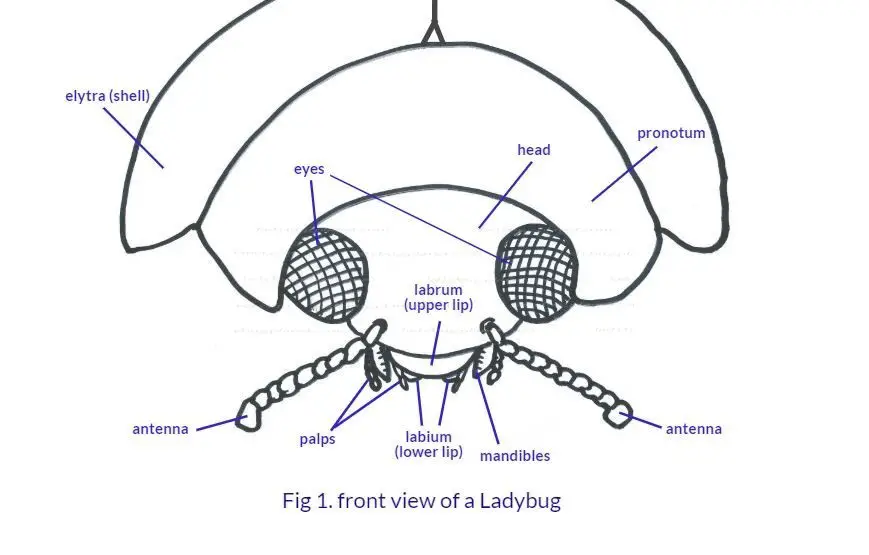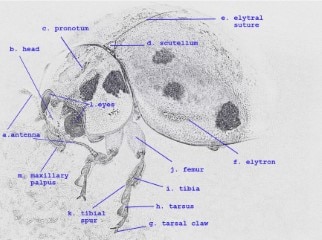Ladybugs are such tiny yet interesting creatures. I’ve researched the anatomy of a ladybug more closely, considering they have such tiny bodies. Turns out they have really interesting anatomy.
How Many Legs Does a Ladybug have?
Ladybugs have six legs. This is consistent across all Ladybugs and in fact all species of beetle. Other parts of a Ladybug’s anatomy have subtle variations in their body structures which may not be visible to the naked eye but distinguishes them from other tribes.
Let’s get into more details…
Anatomy of a Ladybug
The Shapes and Sizes Ladybugs Come In
Ladybugs can vary greatly in size. While the more common red-and-black Ladybug is usually 0.3 to 0.7 inches (0.8 to 18mm ) in length, other species can be smaller or larger.
For example, the Asian Lady Beetle is larger in size. But other species of Ladybugs exist which are less than 1mm in length. Generally, the males are smaller than the females. Here’s How to tell males and females apart.
While some Ladybugs are oval or dome-shaped, others can be a bit more elongated. While some species will sport two or three different colors, others will have no more than one color. Some species can have stripes or dots while others will have no striation marks of any sort. That is how widespread a variety of the Coccinellidae family has.
However, despite there being so many variations in shape, size, and colors, body anatomy remains the same. More on that in the next section.
Anatomy of a Ladybug – Main Parts of the Ladybug Anatomy
The Ladybug’s body is divided into three parts – head, thorax, and abdomen. However, these main parts are composed of a number of varying body parts which work together in performing different functions for the body.
Head
In general, the head of a coccinellid is wider than it is long. The corners of the head are rounded. The area of the head above the eyes is important for higher classification of the family for Entomologists. The antenna insertions are generally lateral and broadly separated.

Eyes
Ladybugs have compound eyes which are very well-developed, particularly for short-range vision.
Although technically well developed, the compound eyes of the Ladybug are not the most evolved in terms of quality of vision. They can
However, over a long distance, the Ladybug will not see a fully clear image. Other than larger shapes as needed, for example, a group of large blooming flower heads. They largely rely on their antennae for assimilating the world around them beyond a few inches or so (see Antenna details below).
Below is an image of how Ladybugs are likely to view the world around them – which to them is shades of grey from black to white. This is an impression only and does not take account of the compound eye setup, but provides something of an indication.
The eyes can be hairless, or contain sparingly to densely populated short hairs.
source: nbair.res.in
Some species like the Hyperaspis Maindroni Sicard, have eyes covered with metallic green or purplish luminescence.
This is especially true for the specimens when they’re still alive.
The eyes tend to shimmer from different angles and the color of the eyes varies based on the specific sub-family.
Antennae
The antennae are one of the body parts other than the eyes and mouthparts that are classified mainly as part of the head of the Ladybug.
However, the actual head of the Ladybug is rather internally set back under the pronotum and does not take up much area in the Ladybug’s body.
The antennae are one of the most significant organs of the insect, particularly because it acts as a radar of sorts and allows it to perceive the world around it.
Given they do not have great eyesight (Ladybugs can only see in black and white and cannot perceive any color), their antennae serve as their receptor to changes in vibration, heat, and other aspects which allow for their survival.
The antennae of coccinellids are actually segmented. They can have anywhere between 6-11 segments in their antennae. As a result, the antennae
The length of the antennae also varies greatly between species. For some tribes, it can be as short as 1/5th the width of the head, but for others, it can be as long as 1.5 times the entire width of the head.
Mouth Parts

Mouth Parts are Outlined in Fig.2 above.
a. labrum (upper lip)
b. labium (lower lip)
c. palps (sense & taste)
d. maxillae (grabbing & holding)
e. mandibles (biting & slicing)
A Ladybug’s mouthparts are adapted for two basic functions – biting and chewing. Based on their diet, Ladybugs are mostly omnivores. They enjoy carnivorous diets based on aphids and small insects, as well as some vegetarian diet feeding on nectar, fungus, plant leaves, etc. As a result, their mandibles need to be equipped in a manner capable of handling both kinds of meals.
Do Ladybugs Have Teeth?
No, Even though they are omnivores, they do not have any sets of teeth as many omnivores do, their set of mandibles do most of the work of biting which would normally be carried out by teeth.
The mandibles are shaped like a sickle and are large in size. The shape and the size of the mandible help the insects to collect their prey and bite into it while piecing it to help in digestion as well.
The mandibles are generally straight-edged in carnivorous species, but a plant-feeder can have serrated-edge-like teeth good for slicing leaves and other plant materials. In species that prefer fungus as their source of diet, a series of serrated edges are used to comb out fungal spores.
Thorax
The thorax is actually a large area. In some of the tribes, the thorax will partially cover the head. In some rare cases, they might actually be pulled forward to entirely cover the head. The scutellum is the triangle part that exists where the elytra meet near the pronotum. See Fig 2.
Fig 2. The main body parts when viewed from the front, and listed below.
- a. antenna
- b. head
- c. pronotum
- d. scutellum
- e. elytral suture
- f. elytron
- g. tarsal claw
- h. tarsus
- i. tibia
- j. femur
- k. tibial spur
- l. eyes
- m. maxillary palpus
Elytra
The elytra are characterized has hard wings that cover the abdomen. The texture of this area is said to be leathery and the purpose is to protect the abdomen. It is convex-shaped and will meet in the middle forming a line along the entire length.
This meeting line is known as the sutural line/elytral suture (see Fig 2.). The humeral callus is generally well-developed but can vary depending on the groups
Wings
The wings on the back are tucked under the Elytra, they’re thin and are the actual wings that enable the Ladybug to fly.
They’re quite fragile but adequate for the Ladybug’s needs, which is why they’re protected by the elytra. They are formed as a thin membrane and fold inward in a concertina style. Although they’re a thin membrane, they are able to lift and maintain flight for the ladybug and its weight for long distances. Except in the Lithophilini tribe, where the wings are completely absent.
Legs
Ladybugs have 6 legs. These legs need to be strong and capable of walking and running as well as taking on the pressure of landing from a flight. The ‘bones’ are generally hollow.
In Fig. 3 below you can see the lower leg structures that represent most of the lady Beetle species.

Both females and males have the same number of segments on their legs. The feet are also able to taste and smell and enable
Abdomen
The abdomen of a Ladybug has five or six different segments. Generally, both males and females have the same number of segments.
However, some species have a different number of segments for each gender. For example, in the Chilocorini tribe, the males have six, while the females have five segments.
The last or last two segments are differently developed in males and females. It can either be whole or notched to a certain degree in males. In females, it can be evenly rounded or divided. There are the ninth and tenth parts of the abdomen as well. These are known as the genitalia and are covered in the next segments.
Anatomy of a Ladybug – Ladybug Blood
Ladybugs are known for being able to emit liquid from their leg joints when feeling threatened or being attacked. The liquid released is actually their own blood and this is called ‘reflex bleeding.’

The liquid is unpleasant for most animals, but for some, mainly the smaller insect variety could be quite toxic for them.
The blood is a form of alkaline which induces a bad smell and a bad taste.
Above is the chemical formula for this liquid, called pyrazine. This reflex bleeding forms part of the five ladybug protection mechanisms.
Male Genitalia
The male genitalia of a Ladybug is comprised of two parts – tegmen and sipho. The tegmen acts as a base piece. The tegmen, along with its various components, is also known as the aedeagus.
The
Female Genitalia
The female genitalia comprises genital plates, an accessory gland along with a sperm duct. The sperm duct and the accessory gland are connected.
Why Ladybugs Are Classed As Beetles
Despite being called Ladybugs, these insects actually belong to the beetle family. The term ‘bugs’ has been erroneously used for centuries and has since then been a part of their identity.
Originally, they were called ‘Beetle of Our Lady’, where ‘lady’ refers to the Virgin Mary. Farmers were frustrated with pest problems and had continuously prayed to the Virgin Mary for help.
Ladybugs arrived upon the crops and saved them. That’s how the name stuck. But throughout the world, they’re known by a variety of names.
They’re
20% of all insect species in the world
are part of the beetle family
Can Ladybugs Regrow Legs or Other Body Parts?
Sadly, Ladybugs cannot regrow their legs, antenna, wings, or any other body parts. The loss of a single leg can probably be coped with, however, a damaged wing is very difficult to repair and in the

Anatomy of a Ladybug – How To Identify a Ladybug
While Ladybugs are generally thought to be red and black spotted insects that can be found in our garden, they are actually much more complex. In fact, there are many species that do not sport red color or black spots.
Ladybugs range between 0.3 to 0.7 inches (0.8 to 18mm ) in length. They’re small and elliptical or round in shape. The most common Ladybug colors are red, orange, yellow, black, white/grey, and brown.
Most of them have spots or markings on their back, though in varying numbers. The number of spots on their back depends on the species and provides us with a taxonomic marker in identifying which species classification they belong to.
A key identifier used for Ladybugs is the pronotum area of their body. This is the area of the thorax where the legs and wings are joined with the body. If you look at this area, in particular, they may have light or dark spots around the joints. The variety of spots, color, and striation acts are markers to identify the species.
Anatomy of a Ladybug – Wrapping Up
As t
Across the world, there are thousands of Ladybug species and while not all of them might be as useful as our North American or European red with black spots Ladybug, they are still a beautiful creation.
Using taxonomic markers on their pronotum, legs, and head, one can identify the group of Ladybug they are dealing with. So, enjoy your time with these beautiful pets, and keep learning!
If you want to know more, these related articles might help you
The Guide to Ladybugs, Varieties, Habitat, Diet, Anatomy, and More
How Long Do Ladybugs Live? – the Life Cycle of the Ladybird
Related Questions:
How many wings does a Ladybug have? A Ladybug has two pairs of wings. The first pair of wings are hardened elytra similar to fingernail material. These wings protect the other pair, which are comparatively fragile. The second pair of wings are actually used for flying, while the hardened layer actually offers more by way of protection.
How many spots does a Ladybug have? A Ladybug can have anywhere from 2-28 spots. The number of spots varies from one species to another. These Spots have developed over thousands of years of evolution and denote the separated species. I wrote more extensively about spots in my article What Do the Spots on a Ladybug Mean.
Do Ladybugs have tails? Ladybugs do not have tails. If they have not fully folded their wings, or if they are older and unable to fully fold their wings, then this may be mistaken for a tail. It is. Other reasons Ladybugs may not fully fold their wings could possibly be if they’re wet, or hot.


